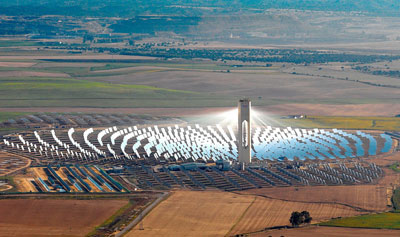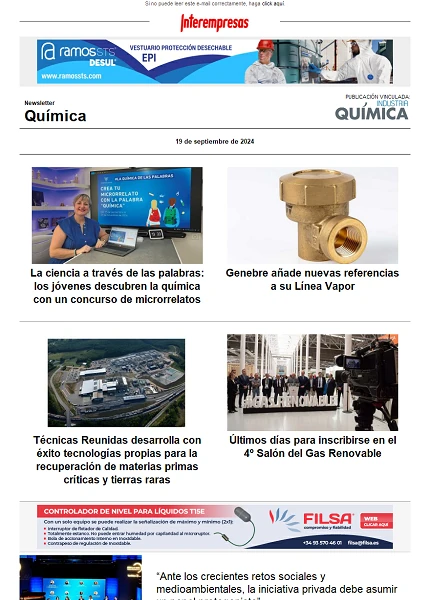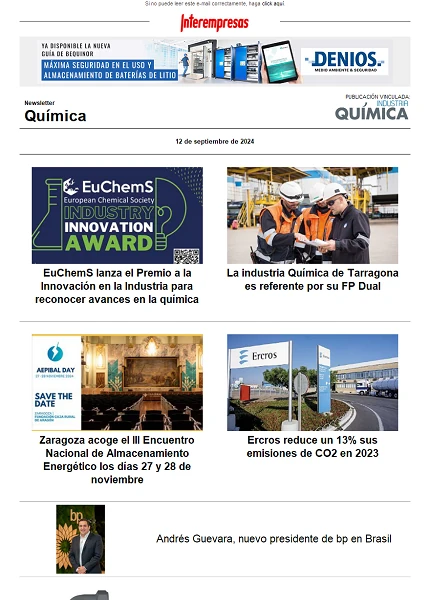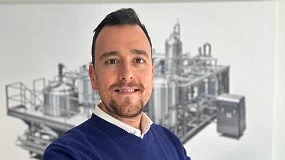“El futuro de las centrales solares termoeléctricas es muy prometedor”
Entrevista a José Jacinto Monge, profesor titular de Química Industrial y del máster en Tecnología Química, Energética y de Materiales de la Universidad Rey Juan Carlos
Redacción Interempresas12/09/2011
12 de septiembre de 2011
Jacinto Monge tiene más de 30 años de experiencia en las industrias de las energías renovables, el petróleo y químicas en compañías como Cristalería Española (Grupo Saint-Gobain), Unión Explosivos Río Tinto, RepsolYPF, la Asociación Europea de las Industrias del Petróleo (EUROPIA) y Green Fuel Corporación. En la actualidad, es Profesor Titular de Química Industrial en la Universidad Rey Juan Carlos I y consultor en asuntos energéticos. En los últimos 15 años, ha sido experto para la Comisión Europea para el desarrollo de políticas tecnológicas y evaluación de proyectos de I+DT.
En el marco de Expoquimia, se ha organizado una jornada para debatir acerca de las centrales solares termoeléctricas, que están experimentando un espectacular crecimiento en todo el mundo. ¿Por qué es importante que el salón acoja una jornada sobre esta temática?
Hoy en día, el aprovechamiento térmico a alta temperatura de la energía solar concentrada, en las llamadas centrales eléctricas termosolares está registrando un auge con multitud de proyectos comerciales en España y EE UU. España juega, sin duda, un papel de liderazgo y el número de agentes involucrados en su desarrollo ha crecido muy rápidamente abarcando desde ingenierías a promotores, suministradores de componentes, instaladores, etc. Este escenario tan prometedor se ve, sin embargo, ensombrecido por el hecho de que la generación actual de plantas solares termoeléctricas todavía se basa fundamentalmente en esquemas y dispositivos tecnológicamente conservadores. En un salón como Expoquimia se pueden abordar mejoras sustanciales en materiales y componentes importantes, como por ejemplo el uso de fluidos térmicos que permitan trabajar a temperaturas más elevadas; el uso de reacciones termoquímicas para el almacenamiento de la energía excedente o la producción de combustibles sintéticos.
¿Nos puede explicar en qué se diferencian este tipo de centrales de las tradicionales centrales térmicas o las más extendidas centrales fotovoltaicas?
En ambas tecnologías el recurso energético es el mismo: la energía solar. No obstante, el procedimiento de conversión de la irradiancia en energía eléctrica es muy diferente. A pesar de ello, más que competidoras, yo diría que son tecnologías que se complementan muy bien. Las aplicaciones de la energía solar fotovoltaica están basadas en el aprovechamiento del efecto fotovoltaico que resulta al incidir la radiación solar sobre un cierto tipo de materiales semiconductores. Es una conversión directa y elegante de la radiación solar en electricidad. En el caso de las centrales termosolares, sin embargo, se utilizan grandes superficies de espejos que reflejan y concentran la radiación solar sobre una caldera o intercambiador de calor en el cual se calienta un fluido térmico hasta temperaturas lo suficientemente elevadas para generar vapor sobrecalentado o calentar un gas que posteriormente se expandirá en una turbina. Las centrales solares termoeléctricas, al manejar grandes cantidades de fluidos térmicos, permiten acumular la energía en forma térmica durante horas y adaptar la generación eléctrica de origen solar a las curvas de demanda.
La jornada tratará del uso de nuevos materiales y fluidos térmicos en el funcionamiento de este tipo de centrales. ¿Por qué se plantean el uso de nuevos materiales? ¿Cuáles son los retos que ha de afrontar este tipo de central?
En España, tenemos en la actualidad 2.500 MW de plantas termosolares en desarrollo, que estarán plenamente operativos en el año 2013. La previsión del nuevo Plan Nacional de Energías Renovables (PANER) es que esta tecnología alcance los 5.000 MW instalados en el año 2020. Sin embargo, uno de los riesgos en el momento actual es que los primeros 2.500 MW utilizan en un 94% tecnologías muy conservadoras, con materiales reflectantes caros, que pueden representar hasta un 40% del coste total de la inversión, y operan con fluidos térmicos a temperaturas relativamente modestas (por debajo de 400 °C). La consecuencia más inmediata de estos diseños conservadores es el uso de sistemas con eficiencias inferiores al 20%, la limitación para integrar sistemas de almacenamiento de energía y para alcanzar las temperaturas necesarias para procesos de producción de combustibles sintéticos. La presente Jornada de Difusión Técnica presenta algunas aportaciones novedosas en el ámbito de los reflectores y absorbedores solares y en el de los fluidos térmicos para el circuito de refrigeración del campo solar y el sistema de almacenamiento de energía, dos de los componentes con mayor incidencia en el coste y eficiencia de los sistemas termosolares y donde la química y la ciencia de materiales juegan un papel esencial.
Teniendo en cuenta las características de nuestro país, ¿cree que este tipo de centrales serán las que nos proveerán mayoritariamente de energía en los próximos años?
Lo que es indudable es que todos los escenarios que se publican por parte de expertos, la Agencia Internacional de la Energía o asociaciones ecologistas, cuentan para la penetración masiva de las energías renovables con las tres grandes: eólica, fotovoltaica y termosolar. Los nuevos compromisos asumidos por los Estado Miembros en la Unión Europea de alcanzar un 20% de penetración de las energías renovables en el año 2020 y valores muy altos en el caso de la producción eléctrica -España planea alcanzar ese año un 40% de participación de la electricidad renovable en el conjunto de generación nacional-, hacen ineludible la promoción de la energía solar termoeléctrica en los países soleados del sur de Europa, y deben de hacerlo complementando a la fotovoltaica, toda vez que esta última no tiene capacidad de almacenamiento y adaptación a la demanda. En un estudio realizado para Greenpeace por la Universidad Pontificia de Comillas (Madrid) en 2005, se estimaba que la energía solar termoeléctrica podría técnicamente cubrir 35 veces la demanda total de electricidad de España en el año 2050. De momento, sabemos que el objetivo para el año 2020 en España se cifra en 5.000 MW y en EE UU supera los 10.000 MW. A este desarrollo, se están uniendo otros países como India que, recientemente, ha presentado el programa denominado Solar Mission, que contempla un total de 20 GW de electricidad solar entre plantas fotovoltaicas y termosolares. Otros países que están impulsando proyectos termosolares son Argelia, Australia, Sudáfrica y, más recientemente, Chile.
¿Qué nos puede decir del impacto medioambiental que provocan este tipo de centrales? ¿Es un tipo de energía sostenible?
Los principales impactos asociados a este tipo de centrales son el uso intensivo de terreno y el consumo de agua. Una planta típica de 50 MW puede ocupar más de 1 kilometro cuadrado de terreno, por lo que es necesario que su implantación se priorice en terrenos marginales donde el impacto ambiental sea mínimo. En cuanto al consumo de agua, éste está asociado fundamentalmente a la refrigeración en el circuito de vapor, como ocurre en todas las centrales térmicas convencionales con torres de refrigeración abiertas a la atmósfera. La tendencia a corto plazo es forzar a que los proyectos incorporen sistemas de refrigeración seca con enfriamiento en circuito cerrado con lo que el consumo de agua se reduciría en un 90%. Lógicamente eso tiene un sobrecoste y penaliza en un 3-5% el rendimiento, por lo que probablemente habrá que introducirlo como obligación.
En este sentido, el cumplimiento con el Protocolo de Kyoto en cuanto a las emisiones de C02, ¿supone una desventaja o un nuevo reto para el desarrollo de estas centrales?
Es, sin duda, uno de los elementos movilizadores de esta tecnología, junto con la creación de empleo y la seguridad del suministro energético. Buena muestra de la importancia que están cobrando las energías renovables en el contexto energético internacional es que la propia Agencia Internacional de la Energía (AIE) en su análisis de perspectivas tecnológicas publicado en 2010 (ETP2010-Energy Technology Perspectives) reconoce que, para cumplir con los objetivos de reducción de emisiones para el año 2050, es necesaria una importante penetración de tecnología renovables, que supondrían hasta un 17% en la contribución de reducción de emisiones de CO2 en el planeta. Hasta hace poco, objetivos tan ambiciosos de penetración sólo eran contemplados por los paneles del cambio climático e instituciones medioambientales. Para que estos objetivos de reducción de emisiones se cumplan el escenario que plantea la AIE es que deben montarse entre 10.000 y 20.000 MW de nuevas plantas termosolares en los próximos 40 años. Cada MW de planta termosolar viene a evitar unas 1.000 toneladas de emisiones de CO2 al año.
¿Cuál es el futuro que le augura a las centrales solares termoeléctricas?
En el próximo lustro van a vivir una situación excitante, con un mercado muy dinámico y la aparición de nuevos países interesados. La irrupción de países como India y China va a ser determinante para saber si la curva de reducción de costes se estanca o si los costes pueden pronto reducirse un 60%, que es lo que predice el sector. Esta reducción de costes, junto con el desarrollo de sistemas de almacenamiento de energía más baratos, ha de permitir que los costes de generación bajen de los 0,12 euros/kWh. Deberán ser centrales, no obstante, que aprendan a complementar a las centrales fotovoltaicas. Asimismo deben conseguirse diseños más modulares que permitan la implantación en todo tipo de territorios. El futuro de las centrales solares termoeléctricas es muy prometedor en los países del cinturón solar con buena radiación solar directa.
Las centrales solares termoeléctricas permiten acumular la energía en forma térmica durante horas.
En estos momentos, parece que la solución pasa por las energías alternativas. ¿Cuál es su opinión al respecto? Y la química, ¿qué papel juega en el desarrollo de estas energías?
Las emisiones antropogénicas de gases de efecto invernadero y otros contaminantes pueden reducirse significativamente sustituyendo los combustibles fósiles por energías renovables. Además, las fuentes renovables tienen un carácter autóctono que permite ayudar a diversificar la balanza energética nacional y contribuye a mejorar la seguridad de suministro energético. Una apuesta decidida por las energías renovables permitiría que, en el año 2020, hubiera más de 250.000 puestos de trabajo ligados a estas energías, cifra que por cierto ya ha alcanzado Alemania. Son buenas razones para tener en cuenta a las energías renovables en las prioridades de esta década. En cuanto al papel de la química, creo que es fundamental en algunos de los elementos que se analizan en la Jornada, como por ejemplo en un sistema tan esencial como el almacenamiento de energía. Sin un buen sistema acumulador, estas centrales pierden una gran parte de su atractivo, y la acumulación ha de hacerse bien mediante fluidos térmicos o con reacciones químicas reversibles. A medio plazo, la investigación ha de centrarse en la producción de combustibles solares. A corto plazo la química entra en el abaratamiento de materiales reflectantes, por ejemplo usando polímeros, o en la introducción de materiales compuestos para las grandes estructuras de los concentradores.
Ya por último, en 2011 se celebra el Año Internacional de la Química, ¿cree que, por fin, la sociedad entenderá los beneficios que aporta esta actividad como por ejemplo en la generación de energía eléctrica?
Sin duda, la sociedad entiende los beneficios que la industria química supone para el desarrollo económico y social de todos los ciudadanos. Desde hace más de 150 años, productos químicos han sido fabricados a escala industrial, suponiendo una importante contribución en el suministro alimentos (fertilizantes, fitosanitarios), la higiene (detergentes, cosmética), la salud (medicamentos, vitaminas) y, en general, la prosperidad y el nivel/calidad de vida en todo el mundo. En la actualidad, la industria química juega un papel vital en la sociedad europea y mundial. La industria química supone un 2,4% del Producto Nacional Bruto (PNB) en la Unión Europea y casi un 2% del PNB en los Estados Unidos de América. Es una industria netamente exportadora. Emplea millones de personas y produce más de 70.000 productos diferentes. Es un industria con un alto componente tecnológico y grandes inversiones en investigación y desarrollo (I+D). Mucho más importante, la industria química es una industria “clave”, facilitadora de otras industrias y sectores ya que numerosos de sus productos dependen de productos químicos. Por ejemplo, un coche contiene alrededor de 2.000 euros en productos químicos. Desde el poliuretano, usado para los asientos y el neopreno, utilizado en tuberías y manguitos hasta el nylon, usado en los cinturones de seguridad. El caucho para los neumáticos, polipropileno para parachoques o los glicoles utilizados en los anticongelantes, líquidos de freno y un largo etcétera.
En relación con la importancia de la química en la generación de energía eléctrica, ya hemos mencionado en alguna de las anteriores preguntas el impacto fundamental en la generación de energía fotovoltaica y termosolar. Adicionalmente, en la generación convencional de energía eléctrica, la química juega un papel fundamental en los procesos de captura y almacenamiento de CO2, lo que permitirá el uso de combustibles fósiles evitando las emisiones de CO2. También en los procesos de almacenamiento de electricidad en baterías con reacciones químicas Red-Ox.









































